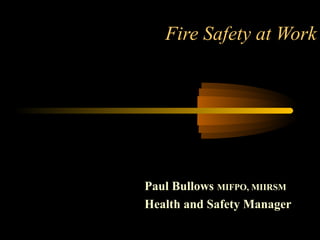
Fire
- 1. Fire Safety at Work Paul Bullows MIFPO, MIIRSM Health and Safety Manager
- 2. Aims of the course To give you an understanding of : • The nature of Fire • Fire hazards and risk • Fire Prevention at work • Local Fire procedures • How to select and use a portable fire extinguisher safely
- 3. Objectives of the course At the end of the course you will • Have an understanding of Fire • Be able to reduce Fire risk at Work • Know what to do when the Fire Alarm sounds • Know what to do if you find a fire • Be able to correctly and safely select and use a fire extinguisher
- 4. Why do we do this training Because management care about your safety Because many people are unnecessarily injured by fire at work each year Because the law specifically requires larger employers to train its staff in Fire Safety Because Fire Risk assessment flagged a need to train staff in Fire Safety
- 5. Lesson Plan • Pre - course assessment • Fire Hazards and Risk • Disaster - A case study • The Nature of Fire • Fire Procedures • Fire Extinguishers • End of course assessment
- 6. To Begin : Pre-course knowledge • 1. What three things are needed for fire to exist • 2. What do you think is the most common cause of fire in industrial premises? • 3. What would you think is the average maximum time allowed for fire evacuation? • 4. What colour is a modern CO2 Extinguisher? • 5. What extinguisher would you use if your
- 7. Fire Hazards and Risk Question : What is the difference between a hazard and a risk ? Answers : A hazard is something with the potential to cause harm or loss. A risk is the likelihood that the hazard will actually cause that harm or loss.
- 8. Fire at Bradford 11th May 1985 • Time : first flame - well alight? • How many died? • Why? • 2-3 Minutes • 56 people lost their lives • Very Poor standards of Fire Safety
- 9. What is Fire? • The rapid oxidation of a fuel evolving heat, particulates, gases and non-ionizing radiation
- 10. Sources of Ignition • Smoking • Electrical equipment • Heaters • Contractors tools and equipment • Arson
- 11. Fuels • Paper & Boxes etc. • Expanded polystyrene beads • Plastics • Solvents • Carpets • Furniture • Waste materials
- 12. Classes of Fire - BS EN 2 • A - Free burning materials, paper, wood, plastics etc. • B - Flammable liquids, petrol, meths, solvents etc. • C - Flammable gases, methane, hydrogen etc. • D - Metals, potassium, sodium, magnesium etc. • F - Cooking fats • Electricity can be involved in any class of fire
- 13. Fire Prevention • Be mindful of Fire Safety • Don’t block fire exits, call points or extinguishers • No smoking policy • Take care when cooking • Observe good security • Don’t wedge Fire Doors open
- 14. Fire Procedure - Fire Alarm • Leave the building immediately • Use the nearest exit • Walk quickly but don’t run closing doors behind you • Do not delay your exit to collect your belongings • Attend the Fire Assembly Point and report to the Fire Warden • Do not return until told to do so
- 15. Fire Procedure - Finding a Fire • Sound the fire alarm • Fight the fire if you are competent and you consider it safe to do so • Evacuate as per normal fire procedure • Inform the Fire Warden
- 16. Fighting a Fire - Do not fight the fire if : - • It is bigger than a waste paper bin • One extinguisher is not enough • Smoke is affecting your breathing • You cannot see the way out • Gas cylinders or chemicals are involved • Your efforts are not reducing the size of the fire
- 17. Extinguishers - European Changes
- 18. Fire Extinguishers - Water • Red body • Suitable for use on Class A Fires, wood and paper etc. • Not suitable for combustible liquids, cooking fats etc. • Not safe to use on fires involving electricity • Extinguishes by cooling
- 19. Fire Extinguishers - Foam • Cream body (Old type) or Red Body with Cream label • Suitable for Class A and B Fires. • Not suitable for use on fires involving electricity • Extinguishes by cooling and sealing the surface of a burning liquid
- 20. Fire Extinguishers - Powder • Blue body (Old type) or Red body with blue label. • Best on Class B fires but safe to use on any type of fire. • Works by chemically interfering with the combustion reaction
- 21. Fire Extinguishers -Carbon Dioxide • Black body (Old type) or red body with black label (New type) • Best on Class B and C fires but safe to use on any type of fire • Safe to use on fires involving electricity • Extinguishes by reducing oxygen levels and cooling
- 22. Fire Extinguishers - Blanket • Any colour body or label but they are usually red or white • For use on any type of fire but best on small contained class B fires and people on fire. • Extinguishes by asphyxiating
- 23. Fire Safety at Home • Fit and maintain a smoke detector • Bin the chip pan • Fit MCBs in fusebox • Check round at night • Close doors at night • Don’t smoke in bed • Prepare an escape plan
- 24. Post Course Knowledge Answers to questions • 1. Fuel, heat and oxygen • 2. Arson ! • 3. 2 minutes • 4. Red • 5. Carbon Dioxide (CO2)
